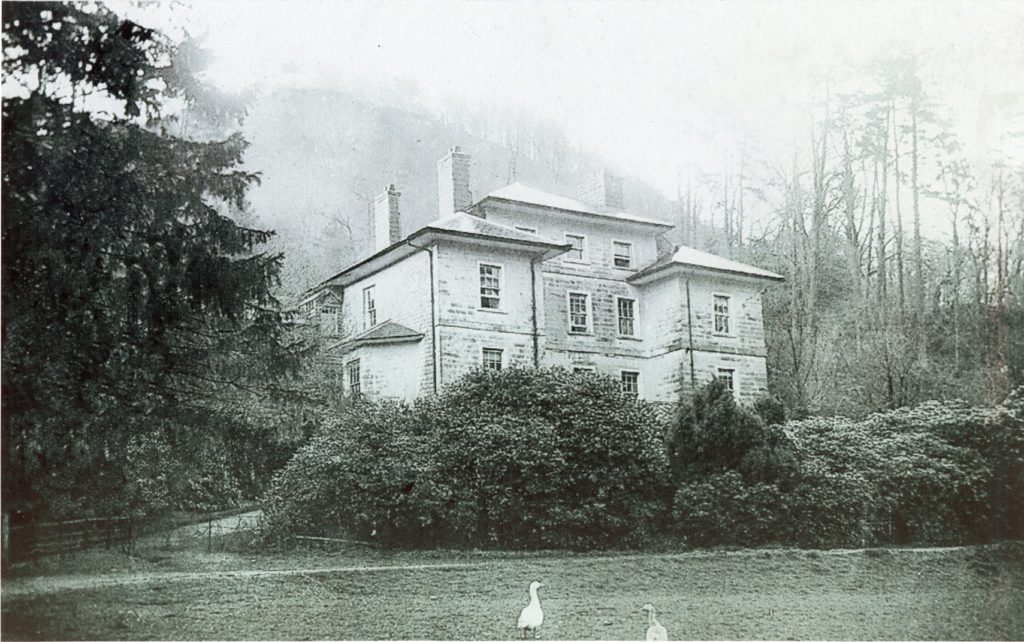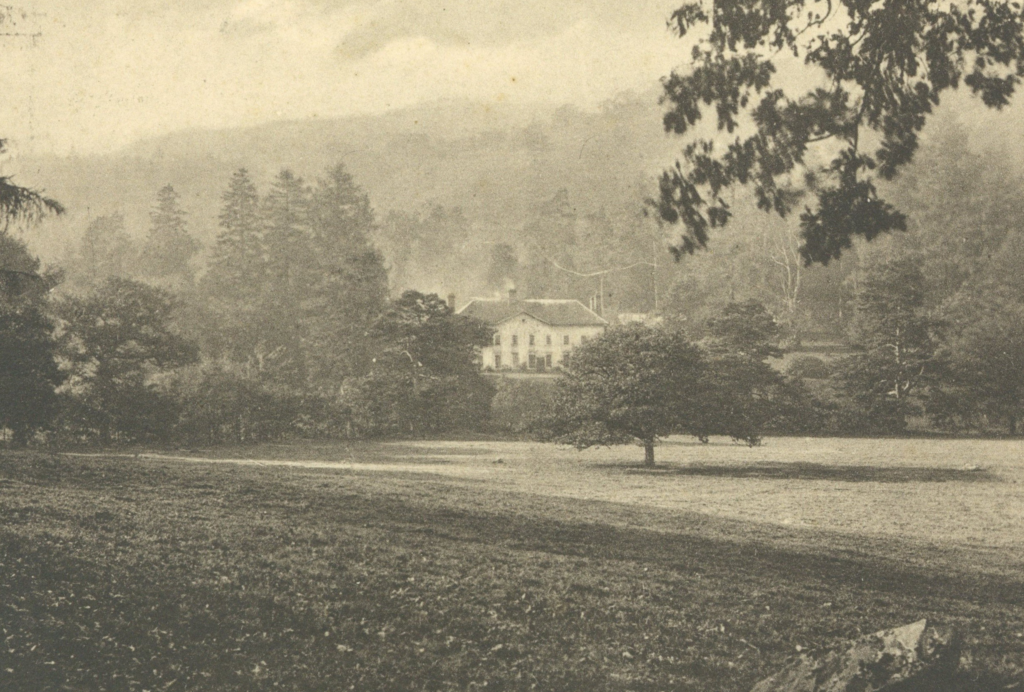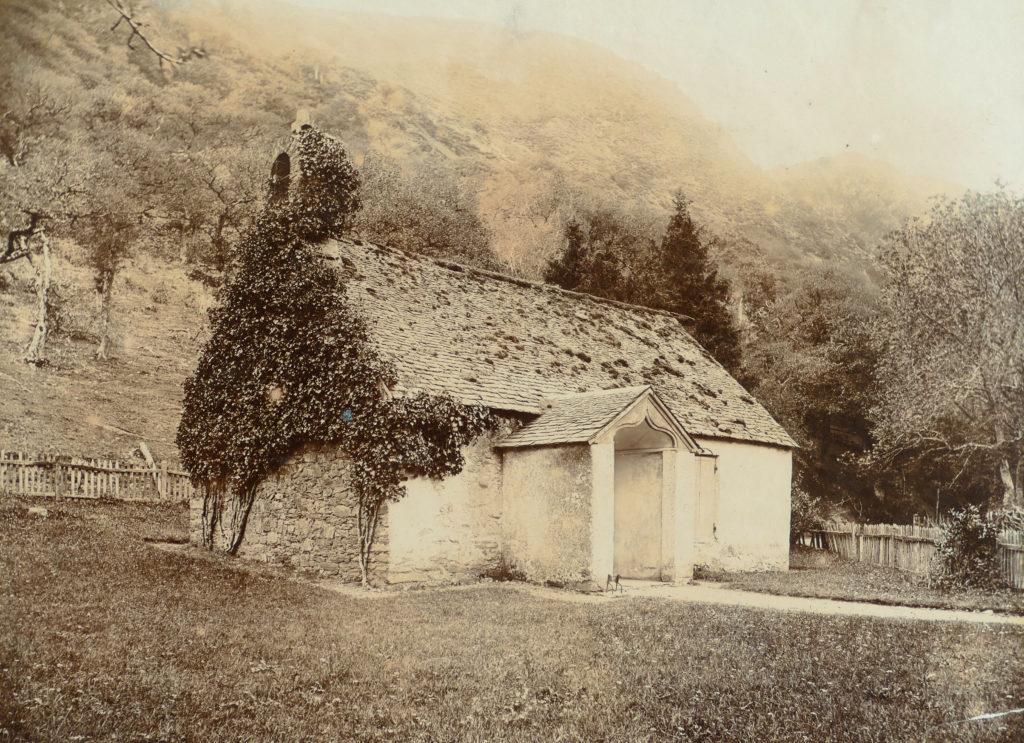
Cwm Elan house – “The Poet Shelley’s House”
The drowned valleys of the rivers Elan and Claerwen each contained a large and historic country house linked with the lyric poet Percy Bysshe Shelley. The estate of Cwm Elan, containing the Elan Valley mansion, was purchased in 1792 by Thomas Grove. It was described then as:
“10,000 worthless acres, which he is now converting into a paradise.”
A local touring guide published in 1892, before the start of the dams project, noted that:
” … the Cwm Elan Estate was purchased early in the century by Mr Grove, a Wiltshire gentleman, and it is to his fostering care that a great part of its present luxuriant beauty is due.”
This Wiltshire gentleman was Shelley’s uncle, and the poet, who came to stay at Cwm Elan on two occasions, was to become very attached to the rugged grandeur of the local landscape.
The house of Cwm Elan stood on the right bank of the River Elan, with a neat lawn sloping down to the rivers edge. In his book “Lost Houses of Wales”, Thomas Lloyd described the house as being “of no great pretension, but its upstanding, Alpine appearance was well contrived to fit its setting.”
Nantgwyllt House
The large manor house of Nantgwyllt, one of two historic houses lost to the Elan dams scheme, was in the lower valley of the River Claerwen, close to its meeting point with the Elan River. Like Cwm Elan, the other large house in the next valley, it was linked with the poet Shelley who was desperate to secure it in 1812 as a home in which to settle with his new young wife Harriet.
Nantgwyllt had been for many generations the family seat of the ancient family of Lewis Lloyd. It was recorded that one of the most striking features of the interior of the house was a very broad and imposing staircase made of old oak.
Today this broad vale to the east lies beneath the large expanse of Caban Coch reservoir, which fills the lower valleys of the two rivers and which covers the site of Nantgwyllt House.
A touring guide published in 1892 noted that “Nantgwyllt mansion is on the borders of the Claerwen, which is here, perhaps, even more beautiful than the Elan. On the undulating lawn between the house and the stream some fine larches are noteworthy.”
The stream referred to in this extract ran past the western side of the house and down into the River Claerwen below. Today the road which leads up the valley to the Claerwen dam of 1952 crosses the Nantgwyllt stream over a small bridge, which serves as a reminder to visitors of the location of the lost house beneath the waters.


Recollections
Hetty Price, a farmer’s daughter who lived in the lower Claerwen valley in the 1880’s, recorded some of her memories of the lost valleys when she was in her seventies. Her father’s farm was on the other side of the River Claerwen opposite “the Grand Mansion of Nantgwyllt where the Squire lived.”
“At Christmas we always had a treat and Christmas tree in the drawing room at Nantgwyllt, and the young ladies waited on us. It was looked forward to for months.”
She recalled the old school attended by the children of the two valleys:
“There was a nice School and School-house attached, kept altogether by Miss Gertrude Lewis Lloyd, a sister of the Squire. She was always doing good deeds, giving suits of clothes for the poorer children, and material to make frocks for the girls.”
The tiny church which served the community was also remembered:
“Lower down the road from the School was Nantgwyllt Church where most of the children and parents of the two valleys went to worship every Sunday afternoon. The Parson had to come all the way from Rhayader on horse back. He had a very long beard, and we children stood in awe of him, and also the Gentry of Nantgwyllt.”


Hetty Price wrote of the Gro-Mill at Nantgwyllt:
“Just by the Church was the Mill, a lovely quaint old wheel fed by a brook, to saw all the timber for the Estate, and also to grind the oats and barley. Nearly every farmer took their grain to be done in the autumn. There was also a kiln to dry the grain. It was done by night, and most of the young men around would congregate to have a good time around the large fire that was kept up all night.”
The little shop, seen at the roadside in the old postcard view of Nantgwyllt, is mentioned in Hetty Price’s account of the lost community:
“Further down the road was Seth Thomas’s Shop where they sold most things, flour and grocery and bottles of sweets, but it was very rare indeed that we should have a penny to buy them.”
The baptist chapel in the Elan Valley, which lay just below the centre of the submerged dam and viaduct of Garreg-ddu on the downstream side, is also described:
“There were stepping stones to cross the river to the little Baptist’s Chapel, where we used to see the converts being baptised in the river. It made a great impression on me as a child.
… On the end of the Chapel was a little house, where a dear old man used to live by himself. He used to lead the singing in the Chapel, and how my sister and I used to love the evenings there! Oh! The memories of it all. It is too sad to think about.”
